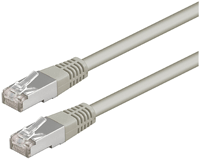If you’ve ever had WiFi problems at home with either your desktop or laptop computer, you may well have longed for some other way to get online and stay online.
These days, WiFi is a necessity in many homes – anyone who has a smartphone or tablet knows that.
But what if you’ve got a computer in a room that doesn’t have a stable WiFi signal? You probably won’t want to move the computer to another room just to get online.
So, what to do?
Connection options.
We usually have one of two options for getting online with a broadband router:
- WiFi – convenient but not always stable
- Ethernet – stable but not always convenient
Both systems have pros and cons, and neither is perfect. My suggested alternative is to use Powerline.
What is Powerline?
Powerline is a system that uses your electrical power sockets to carry the internet signal from your broadband router to another room in your home. This is an amazingly simple but powerful way of banishing WiFi problems and giving your desktop computer or laptop a faster and more stable internet connection.
Because Powerline uses the existing electrical circuitry in your home, you won’t need to worry about running any new wires around your house. (The system does use Ethernet cables, but these can be very short and will often be hidden from view.)
Here’s what you’ll need to get up and running:




Expect to pay around £30 for a pair of Powerline adapters and as little as £3 for a pair of Ethernet (also known as RJ45) cables. Make sure to buy a Powerline kit that is compatible with the HomePlug AV standard (e.g. this one).
Prices vary for a couple of reasons: some Powerline kits offer faster networking speeds; others include a ‘pass-through’ socket that allows other electrical equipment to be plugged in at the same time. You have to decide whether these enhanced features are worth the cost.
How do I connect my Powerline equipment?

Connecting the equipment is easy: just follow the steps below.
Here’s a close-up view of an Ethernet port and cable. Your broadband router and computer/laptop should each have ports that look like this.
Routers usually have four ‘LAN’ Ethernet ports grouped together – any of these are fine for completing step 2 below, but avoid connecting to any port marked ‘WAN’.
Near your broadband router:
- Plug a Powerline adapter in to a free wall socket.
- Connect the adapter to the router, using one of the Ethernet cables.
- Turn on the power to the adapter.
Near your computer/laptop:
- Plug a Powerline adapter in to a free wall socket.
- Connect the adapter to the computer/laptop, using one of the Ethernet cables.
- Turn on the power to the adapter.
You should now be online, because almost all computers and laptops will be set up to allow Ethernet connections to work straight away.
Note that for Powerline to work, the wall sockets used must be on the same electrical circuit – this is the case in most homes.
Bonus feature: using Powerline with other devices.
Because Powerline is really just a way of extending the internet connection around your home, you’re not limited to connecting only computers. Any device that supports Ethernet can be connected to the internet in this way.
For example, Powerline works well with Sky TV boxes. The process is exactly the same as the one above, except that one of the Powerline adapters is connected to a Sky box instead of a computer/laptop. Try it: you’ll immediately benefit from a faster and more reliable On Demand download service.

So long as you buy HomePlug AV-compliant Powerline kit, you could in theory use several Powerline connections in your home.
Downsides of Powerline.
Here are some of the negatives associated with Powerline, though I don’t think any of these should be enough to put people off.
- The kit and cables will cost at least £30.
- There have been reports that Powerline can interfere with local HAM radio setups.
- Powerline adapters work best when plugged directly in to a wall socket rather than in to a power extension. Performance through a power extension might be less than ideal.
- Only devices connected to the same electrical circuit can be used to make Powerline connections. Most homes have a single electrical circuit, so this isn’t often a problem.
Let’s wrap up.
Powerline is an excellent alternative to WiFi, especially in homes where the wireless signal isn’t perfect in all rooms.
Instead of making the effort to run cables around your home, use Powerline to take advantage of your existing electrical wiring.
You’ll have a fast, stable internet connection for quite a small outlay.


